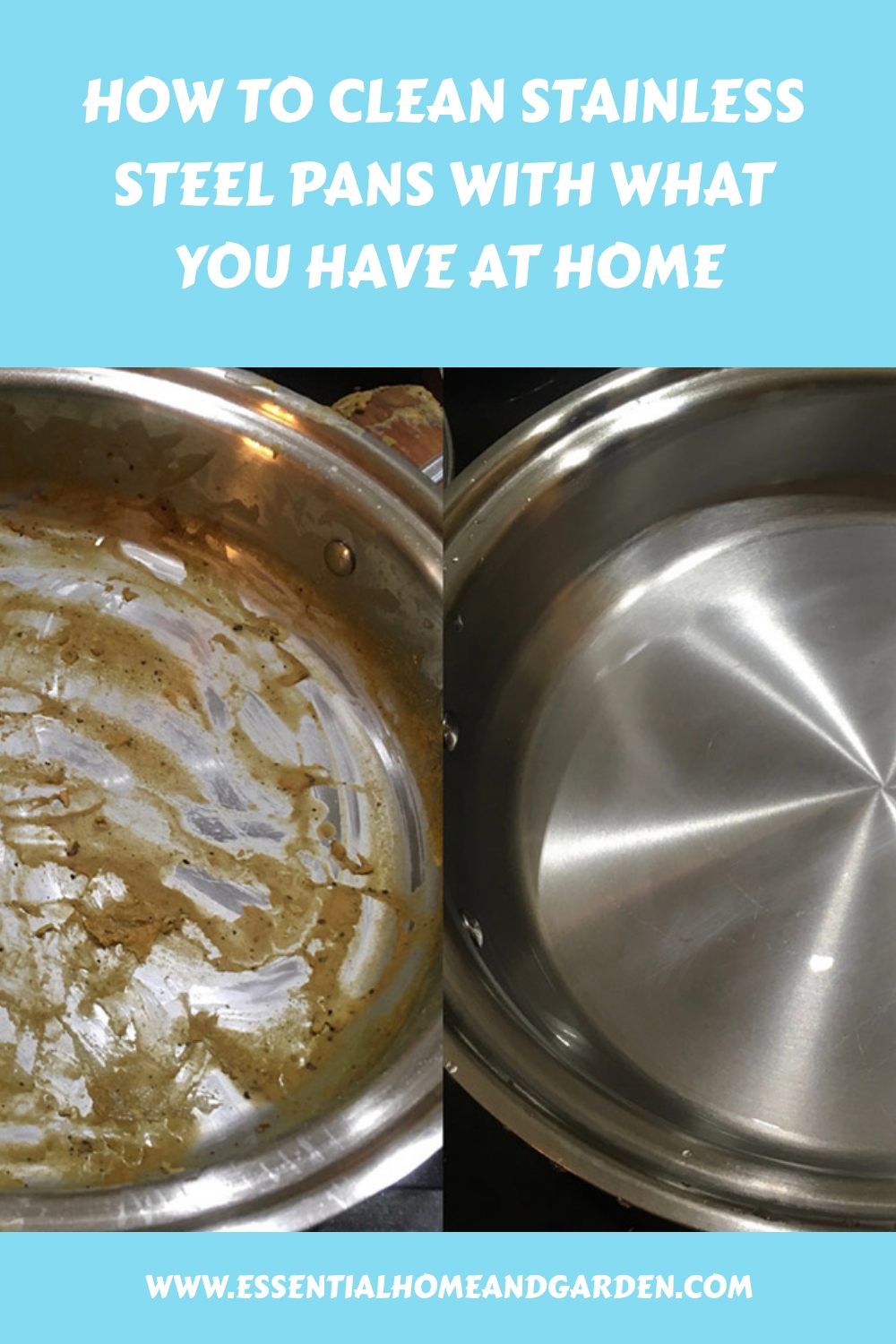If you burn food onto a stainless steel pan or scorch the bottom, there are many easy ways to bring your cookware back to its original shine.
And best of all, your stainless cookware can be cleaned with ingredients you probably already have at home!
In this article, we’ll show you how to clean stainless steel pans using a variety of proven techniques to tackle stain and food removal and to polish and restore.
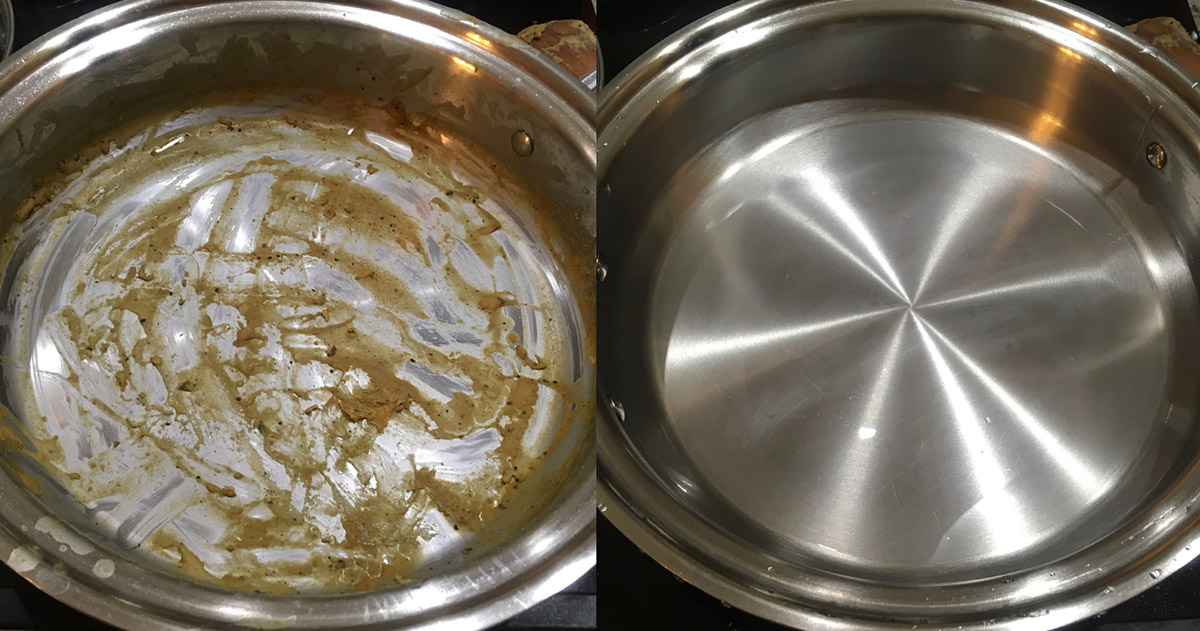
1. Soap and Hot Water
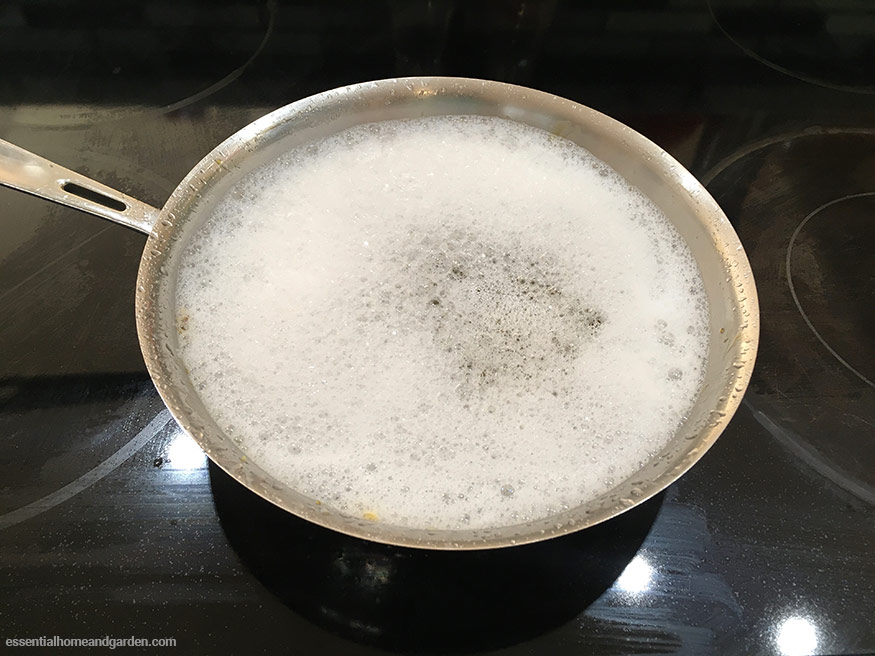
The key to using soap and hot water to clean off burnt food is patience—you need to let that pan soak! The combination of hot water and a degreaser like soap softens burnt-on food and unsticks it from the bottom of the pan.
Once the pan has soaked long enough, it usually takes only a minimal amount of elbow grease to get it looking like new.
What you’ll need:
- Hot tap water
- Dish soap
- Wood or plastic spatula
Instructions:
- Place the pan on a level surface and add a couple of dollops of dish soap
- Using hot tap water, fill the pan to the brim
- Allow the pan to soak for about 30 minutes
- Use a spatula to scrape off the cooked on food
- Finish by washing the entire pan with clean soapy water
Tip: If there is still food stuck to the bottom of the pan after scraping off the softened debris, use one of the methods below to remove those tougher cooked-on particles.
2. Baking Soda
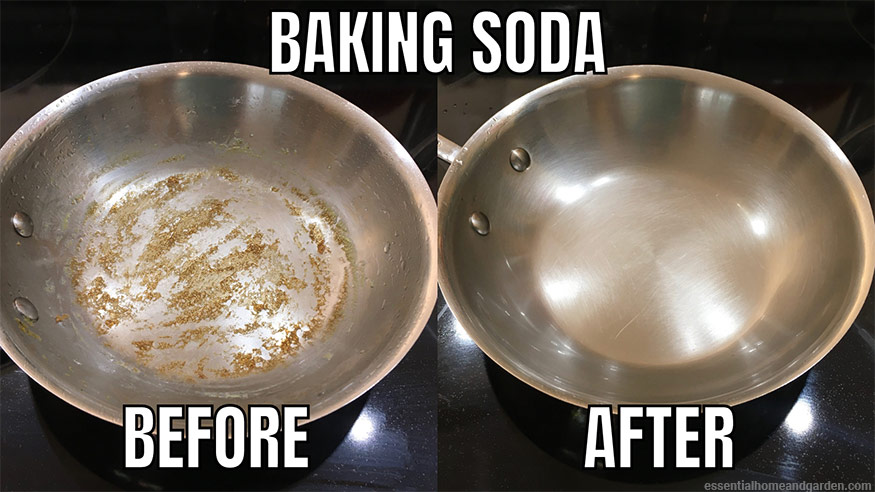
Baking soda is a great abrasive cleaner for stainless steel. It is coarse enough to scrape off food particles, but not hard enough to damage or scratch your pots. Baking soda works best to scrape off that thin layer of food that is left after you’ve already soaked and scraped your pan.
What you’ll need:
- Baking soda
- Wet rag
Instructions:
- After scraping off large food particles with a spatula, sprinkle baking soda on the pan
- With a wet rag, begin scrubbing the bottom of the pan with circular motions
- Re-wet and add more baking soda as needed until the mess has been removed
- Clean the pan with warm soapy water
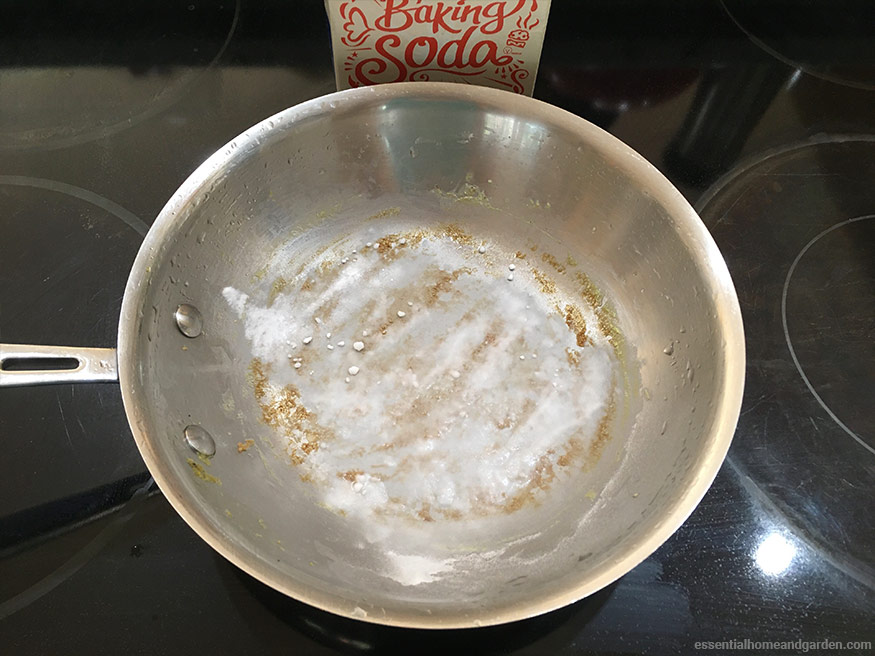
3. Cream of Tartar
Cream of tartar, a form of tartaric acid, is a naturally forming acid. The salt compound of this acid forms during the fermentation of fruits and is commonly mixed with sodium bicarbonate and sold as baking powder.
By itself, cream of tartar makes a powerful cleaner. It is an acidic and abrasive cleaner all in one, making it the perfect substance for cleaning stainless steel.
What you’ll need:
- Cream of tartar
- Warm water
Instructions:
- Mix cream of tartar and water in a small bowl to create a thick watery paste
- After removing large food particles from the pan, dab a rag into the mixture and scrub the remaining burnt food away
- Repeat as needed until the pan is free of burnt food debris
- Clean the entire pan with soap and water
Tip: If you have a really stubborn mess, cover the bottom of the pan with a thin layer of cream of tartar, then add just enough water to make a watery paste. Allow the pan to soak in this paste for about 10 minutes, then scrub.
4. Salt and Lime
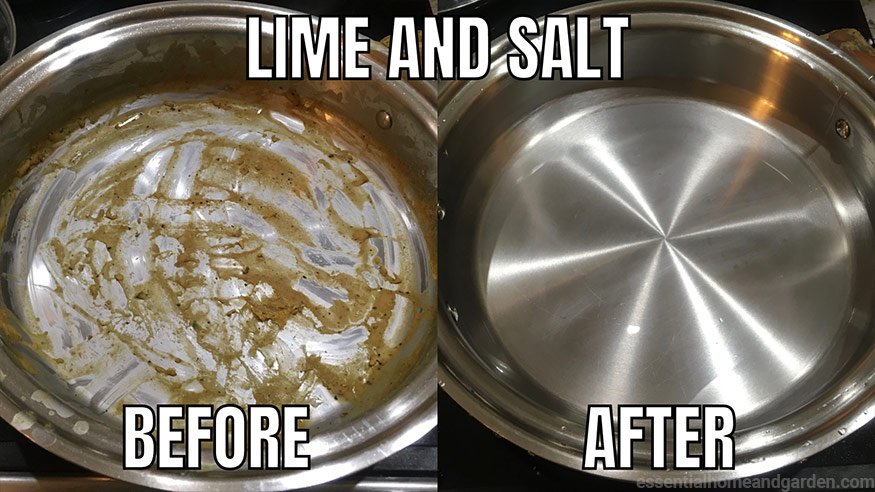
Vinegar isn’t the only naturally occurring acid. Citrus fruits, especially lemons and limes, are naturally very acidic and make great cleaners. I love this method for removing stuck-on food because it comes with a built-in scrubbing device!
What you’ll need:
- Whole lime
- Coarse salt
Instructions:
- After removing the large food debris from the pan, sprinkle the bottom with coarse salt
- Cut your lime in half
- Place one lime half cut side down on the bottom of the pan and begin scrubbing
- Switch out the spent half for the fresh half if needed
- Wash the entire pan with soap and water once all food debris has been scrubbed away
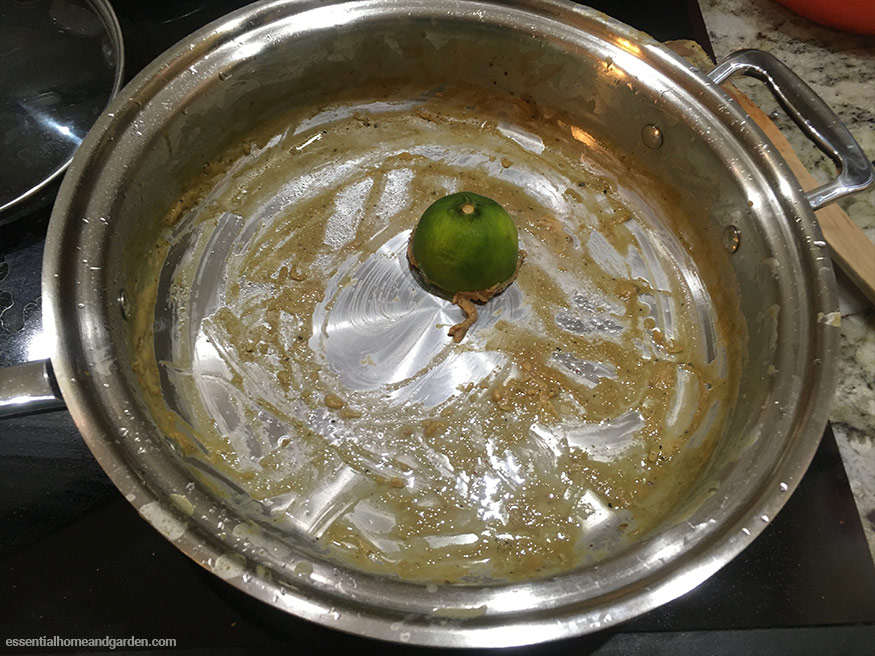
5. Lemon
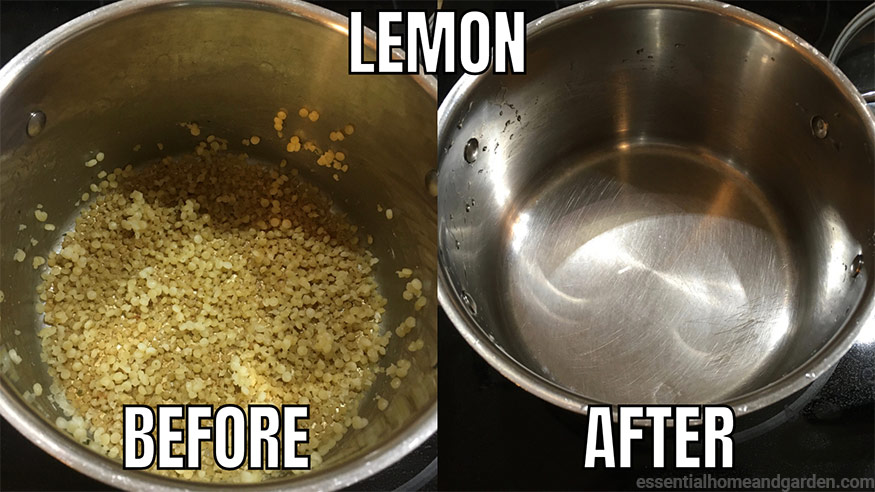
Lemon is another great natural acid that works well for cleaning burnt food on stainless steel pans. You can use fresh lemon to clean your pan via the method above or simply by boiling the lemon as you would vinegar.
The latter method works well for thick stuck-on foods as well as that stubborn under-layer of burnt residue.
What you’ll need:
- Whole lemon
- Water
Instructions:
- Cut your lemon into quarters
- Fill the pot or pan with water and add the lemon pieces
- Bring to a boil
- Turn off the heat and allow the mixture to cool
- Pour the mixture out and use soap and water to finish cleaning the pan
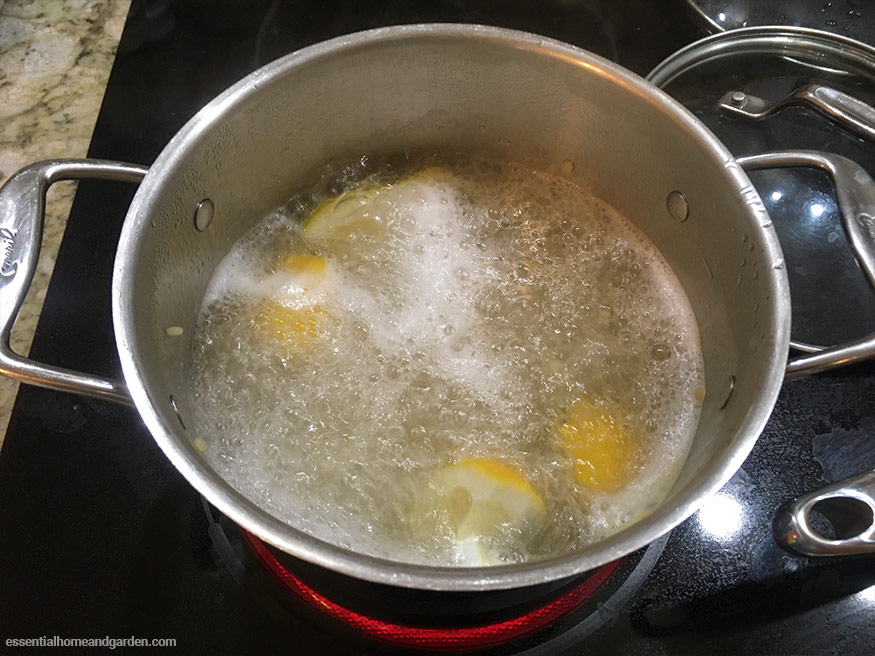
6. Bar Keeper’s Friend
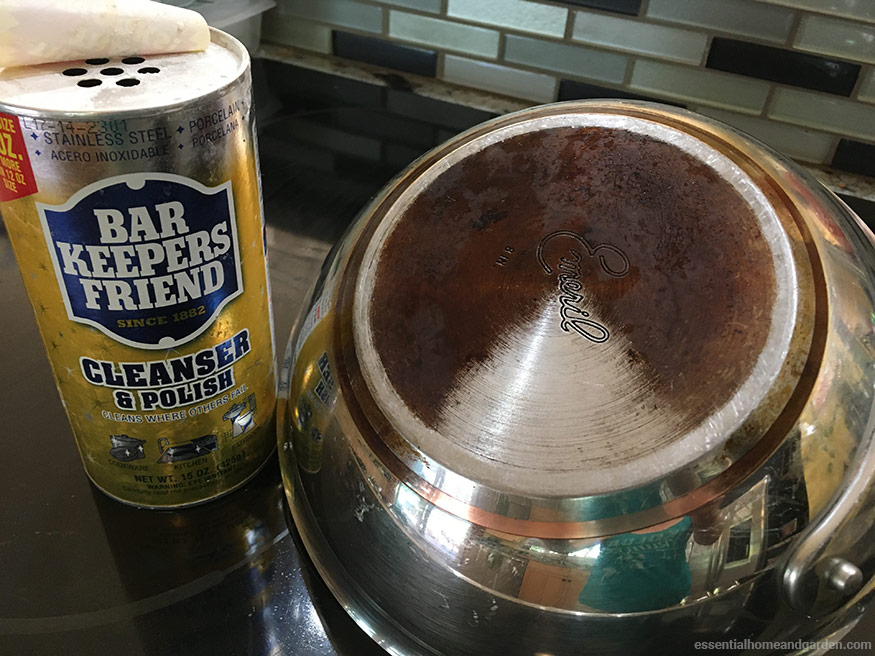
Bar Keeper’s Friend, which is a similar product to Bon Ami, is like baking soda on steroids. In addition to being more abrasive, this mix of powders has acidic and detergent properties, both of which add to its cleaning powder.
If you have especially deep black or stubborn scorch marks on your stainless steel, skip the baking soda and reach straight for Bar Keeper’s Friend.
What you’ll need:
- Bar Keeper’s Friend
- Damp rag
Instructions:
- Sprinkle some Bar Keeper’s Friend onto a damp rag
- Scrub at the burn marks using a circular motion
- Repeat as needed until all have been removed
- Wash the pan with soap and water
7. Ketchup
One of the most unexpected but effective polishing products is ketchup. The acid naturally found in tomatoes reacts with the oxidation of the tarnished metal to remove it. Blended tomatoes would have the same cleansing effect but lack the right texture for polishing metal.
Ketchup is the perfect consistency for scrubbing with and is usually readily available in most homes. Alternatively, you could use tomato paste thinned with a little water.
What you’ll need:
- Ketchup
- Clean damp rag
Instructions:
- Slather ketchup over the entire surface you are hoping to shine
- Let it sit for at least 15 minutes (the longer the better, just don’t let it dry)
- Wipe clean with a damp rag
8. Stainless Steel Cleaner
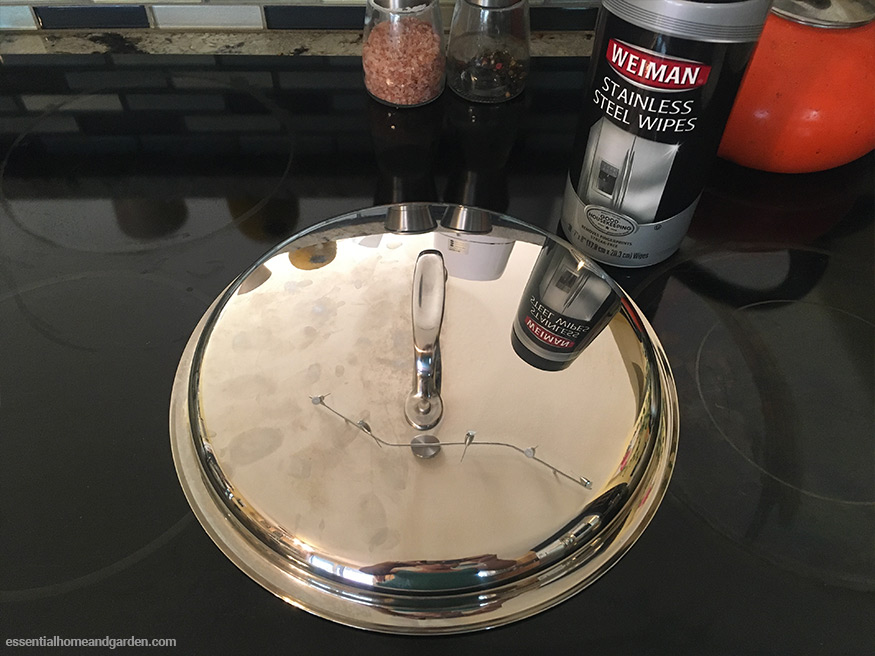
Stainless steel cleaner marketed for polishing up stainless steel appliances also works very well for shining up pots and pans. These products come in wipes and sprays; both work great for cookware. Just be sure to wash the pan with soap and water before cooking, as these chemicals are not meant to be consumed.
What you’ll need:
- Stainless steel cleaner
- Rag (if not using wipes)
Instructions:
- Apply stainless steel cleaner using pre-soaked wipes or a spray bottle
- Scrub using wide circular motions until moisture disappears
- Clean cookware thoroughly with soap and water
- Dry immediately with a clean towel
Tips For Taking Care Of Your Stainless Steel Pans
Using the right materials to clean your stainless steel pots is just one step you can take to assure they continue to look new for years to come. Here are a few more tips for keeping your cookware looking great.
Clean After Each Use
Unlike cast iron, stainless steel pans need to be completely cleaned after each use. To prevent warping, be sure to allow the cookware to cool some before soaking or rinsing it in cold water. But don’t wait too long, or you will have trouble removing the cooked-on food.
Dry As Soon As Possible
Stainless steel is prone to blemishes, which can make it hard to keep this cookware looking its best. The white spots left by hard water are especially noticeable on the shiny surface of these pots and pans. One thing you can do to reduce blemishes is to dry your cookware immediately after washing it. Learn how to clean these white spots off here.
By wiping these pots down with a clean towel, you’ll prevent white spots and watermarks from forming.
Add Salt When Pot Is Boiling
Contrary to popular belief, stainless steel can rust. When salt and oxygen interact with the chromium in stainless steel, it causes pitting, which is a form of rust.
Stainless Steel cookware is most at risk for pitting when exposed to cool salt water. This is because cool water holds a large amount of oxygen. To avoid pitting, do not add salt to your water until it has already started boiling and most of the oxygen has already escaped into the air.
When cleaning with coarse salt, be sure to wipe out the salt and wash the pot with soapy water immediately after you have finished cleaning it. This will prevent pitting from occurring.
Always Pre-Heat Before Adding Oil
As stainless steel heats up, its surface expands. Any material sitting on that surface, whether it’s oil or a chicken cutlet, can get caught within that movement. This is how you end up with stuck-on food residue even when you didn’t burn your meal.
By waiting until the pan has heated up, you’ll be adding oil and food to a slick, naturally nonstick surface, thereby avoiding stuck-on food.
Be sure to heat your pan on medium or medium-low heat only. After a few minutes, flick some water onto the surface. If the water sizzles when it hits, your pan is sufficiently hot.
Cook Room Temperature Food
The tendency of stainless steel to expand and contract when exposed to different temperatures is also the reason you should never add cold food to a hot pan. The low temperature of the introduced food can actually cause the heated pan to rapidly cool and condense.
Not only can this cause warping, but it is sure to trap some food on the surface and make your cleanup job that much more difficult.
To avoid this, allow any refrigerated ingredients to sit out until they reach room temperature before adding them to your pan. Frozen food should be thawed in the fridge and allowed to sit out or heated in the microwave before being added to the pan.
Related Article: The best cookware for gas stoves
Keep Your Stainless Steel Pots and Pans Shiny!
Of all the cookware materials out there, stainless steel is one of the most durable and the easiest to care for. But that doesn’t mean you won’t occasionally have to give it a little extra attention.
Luckily, there are plenty of effective, easy ways to clean stuck-on food, burn marks, and tarnishing from stainless steel pots and pans.
Having trouble cleaning your stainless steel cookware or think you have a better way to get the job done? Comment below to let us know!
